Knowledge Management and Information Systems for Tesco: A Report
VerifiedAdded on 2023/01/11
|12
|4610
|84
Report
AI Summary
This report provides a comprehensive analysis of Tesco's knowledge management and information systems (KMIS). It begins with an overview of Tesco's operations, objectives, and business model, followed by an evaluation of its internal capabilities and the impact of external environmental factors using PESTEL, SWOT, and Porter's Five Forces analyses. The report then offers recommendations for KMIS implementation to enhance Tesco's performance, including strategies for data management and knowledge sharing. It also addresses key challenges Tesco may face during KMIS implementation, such as integration issues, employee training, and data security. The report concludes with a summary of the organization and references to support the analysis. It emphasizes the significance of KMIS in improving decision-making, operational efficiency, and competitive advantage within the retail sector, specifically focusing on Tesco's context.
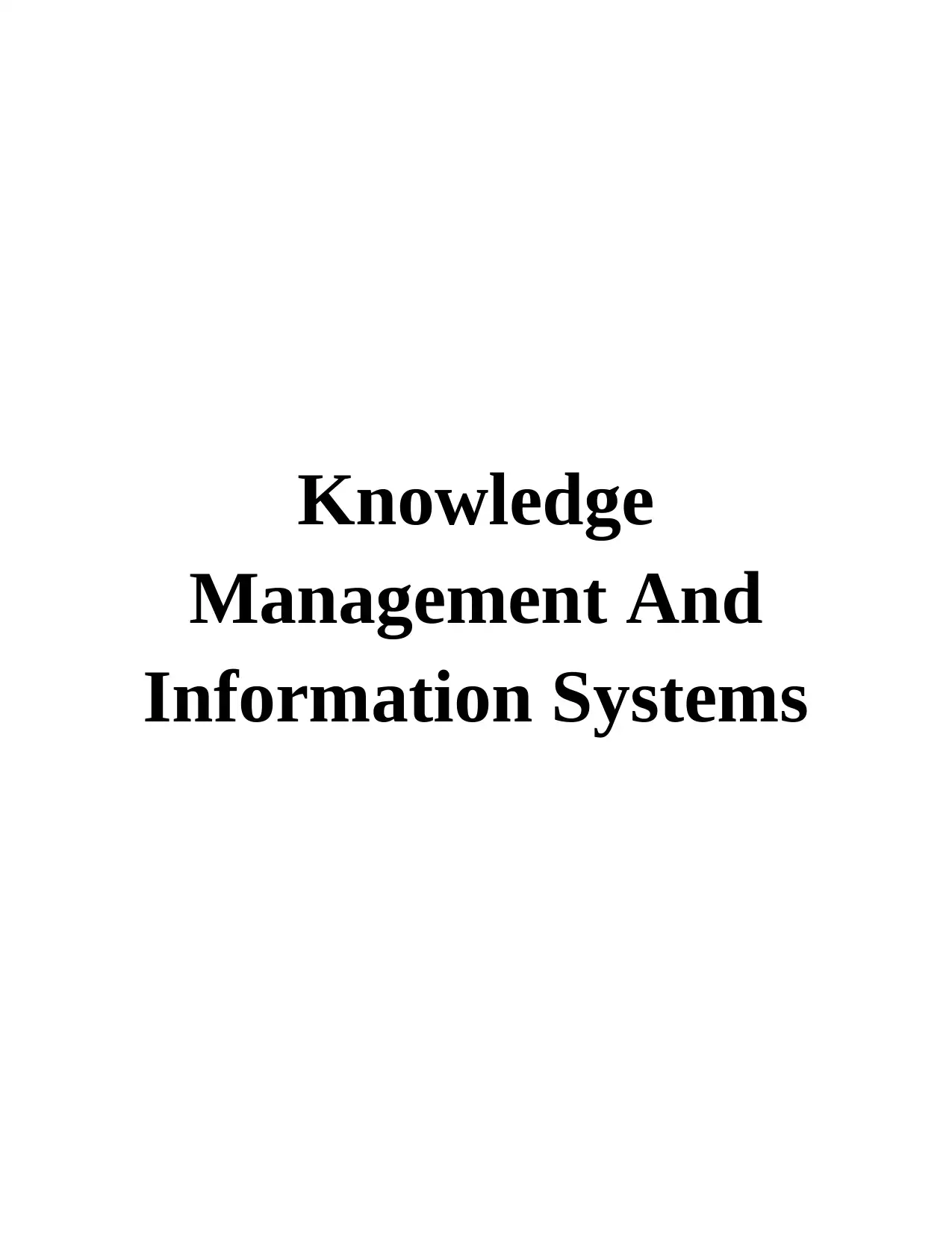
Knowledge
Management And
Information Systems
Management And
Information Systems
Paraphrase This Document
Need a fresh take? Get an instant paraphrase of this document with our AI Paraphraser
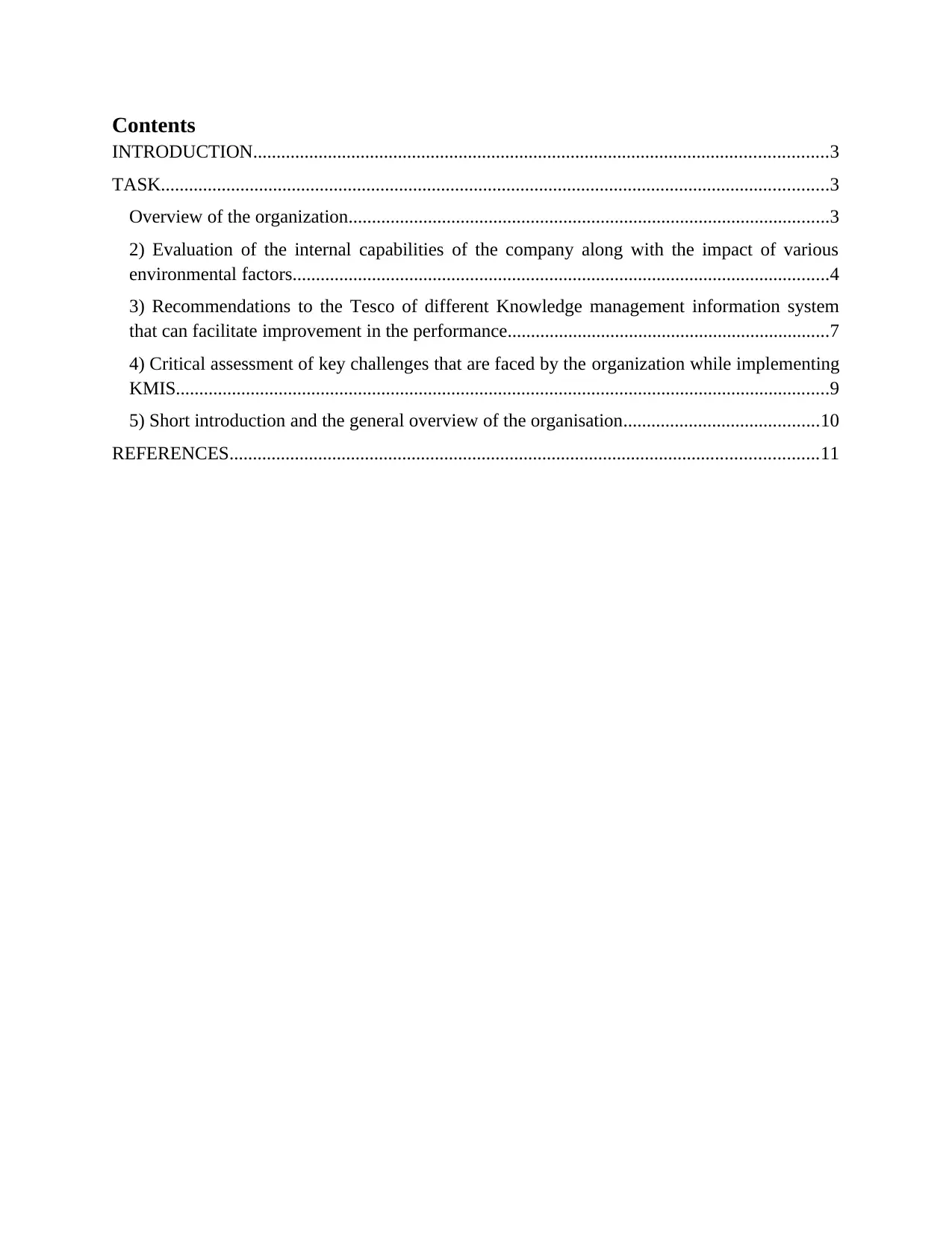
Contents
INTRODUCTION...........................................................................................................................3
TASK...............................................................................................................................................3
Overview of the organization.......................................................................................................3
2) Evaluation of the internal capabilities of the company along with the impact of various
environmental factors...................................................................................................................4
3) Recommendations to the Tesco of different Knowledge management information system
that can facilitate improvement in the performance.....................................................................7
4) Critical assessment of key challenges that are faced by the organization while implementing
KMIS............................................................................................................................................9
5) Short introduction and the general overview of the organisation..........................................10
REFERENCES..............................................................................................................................11
INTRODUCTION...........................................................................................................................3
TASK...............................................................................................................................................3
Overview of the organization.......................................................................................................3
2) Evaluation of the internal capabilities of the company along with the impact of various
environmental factors...................................................................................................................4
3) Recommendations to the Tesco of different Knowledge management information system
that can facilitate improvement in the performance.....................................................................7
4) Critical assessment of key challenges that are faced by the organization while implementing
KMIS............................................................................................................................................9
5) Short introduction and the general overview of the organisation..........................................10
REFERENCES..............................................................................................................................11
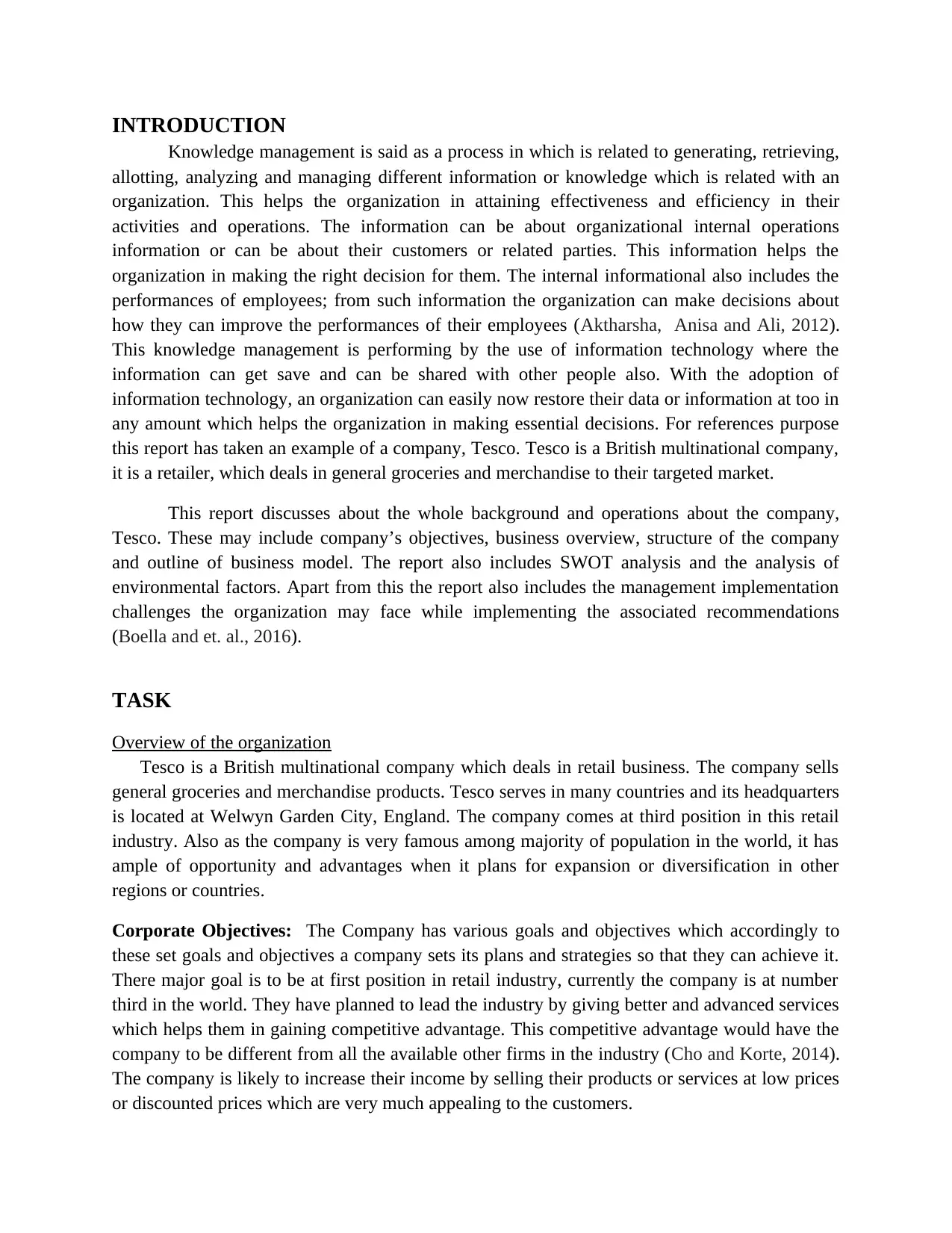
INTRODUCTION
Knowledge management is said as a process in which is related to generating, retrieving,
allotting, analyzing and managing different information or knowledge which is related with an
organization. This helps the organization in attaining effectiveness and efficiency in their
activities and operations. The information can be about organizational internal operations
information or can be about their customers or related parties. This information helps the
organization in making the right decision for them. The internal informational also includes the
performances of employees; from such information the organization can make decisions about
how they can improve the performances of their employees (Aktharsha, Anisa and Ali, 2012).
This knowledge management is performing by the use of information technology where the
information can get save and can be shared with other people also. With the adoption of
information technology, an organization can easily now restore their data or information at too in
any amount which helps the organization in making essential decisions. For references purpose
this report has taken an example of a company, Tesco. Tesco is a British multinational company,
it is a retailer, which deals in general groceries and merchandise to their targeted market.
This report discusses about the whole background and operations about the company,
Tesco. These may include company’s objectives, business overview, structure of the company
and outline of business model. The report also includes SWOT analysis and the analysis of
environmental factors. Apart from this the report also includes the management implementation
challenges the organization may face while implementing the associated recommendations
(Boella and et. al., 2016).
TASK
Overview of the organization
Tesco is a British multinational company which deals in retail business. The company sells
general groceries and merchandise products. Tesco serves in many countries and its headquarters
is located at Welwyn Garden City, England. The company comes at third position in this retail
industry. Also as the company is very famous among majority of population in the world, it has
ample of opportunity and advantages when it plans for expansion or diversification in other
regions or countries.
Corporate Objectives: The Company has various goals and objectives which accordingly to
these set goals and objectives a company sets its plans and strategies so that they can achieve it.
There major goal is to be at first position in retail industry, currently the company is at number
third in the world. They have planned to lead the industry by giving better and advanced services
which helps them in gaining competitive advantage. This competitive advantage would have the
company to be different from all the available other firms in the industry (Cho and Korte, 2014).
The company is likely to increase their income by selling their products or services at low prices
or discounted prices which are very much appealing to the customers.
Knowledge management is said as a process in which is related to generating, retrieving,
allotting, analyzing and managing different information or knowledge which is related with an
organization. This helps the organization in attaining effectiveness and efficiency in their
activities and operations. The information can be about organizational internal operations
information or can be about their customers or related parties. This information helps the
organization in making the right decision for them. The internal informational also includes the
performances of employees; from such information the organization can make decisions about
how they can improve the performances of their employees (Aktharsha, Anisa and Ali, 2012).
This knowledge management is performing by the use of information technology where the
information can get save and can be shared with other people also. With the adoption of
information technology, an organization can easily now restore their data or information at too in
any amount which helps the organization in making essential decisions. For references purpose
this report has taken an example of a company, Tesco. Tesco is a British multinational company,
it is a retailer, which deals in general groceries and merchandise to their targeted market.
This report discusses about the whole background and operations about the company,
Tesco. These may include company’s objectives, business overview, structure of the company
and outline of business model. The report also includes SWOT analysis and the analysis of
environmental factors. Apart from this the report also includes the management implementation
challenges the organization may face while implementing the associated recommendations
(Boella and et. al., 2016).
TASK
Overview of the organization
Tesco is a British multinational company which deals in retail business. The company sells
general groceries and merchandise products. Tesco serves in many countries and its headquarters
is located at Welwyn Garden City, England. The company comes at third position in this retail
industry. Also as the company is very famous among majority of population in the world, it has
ample of opportunity and advantages when it plans for expansion or diversification in other
regions or countries.
Corporate Objectives: The Company has various goals and objectives which accordingly to
these set goals and objectives a company sets its plans and strategies so that they can achieve it.
There major goal is to be at first position in retail industry, currently the company is at number
third in the world. They have planned to lead the industry by giving better and advanced services
which helps them in gaining competitive advantage. This competitive advantage would have the
company to be different from all the available other firms in the industry (Cho and Korte, 2014).
The company is likely to increase their income by selling their products or services at low prices
or discounted prices which are very much appealing to the customers.
⊘ This is a preview!⊘
Do you want full access?
Subscribe today to unlock all pages.

Trusted by 1+ million students worldwide
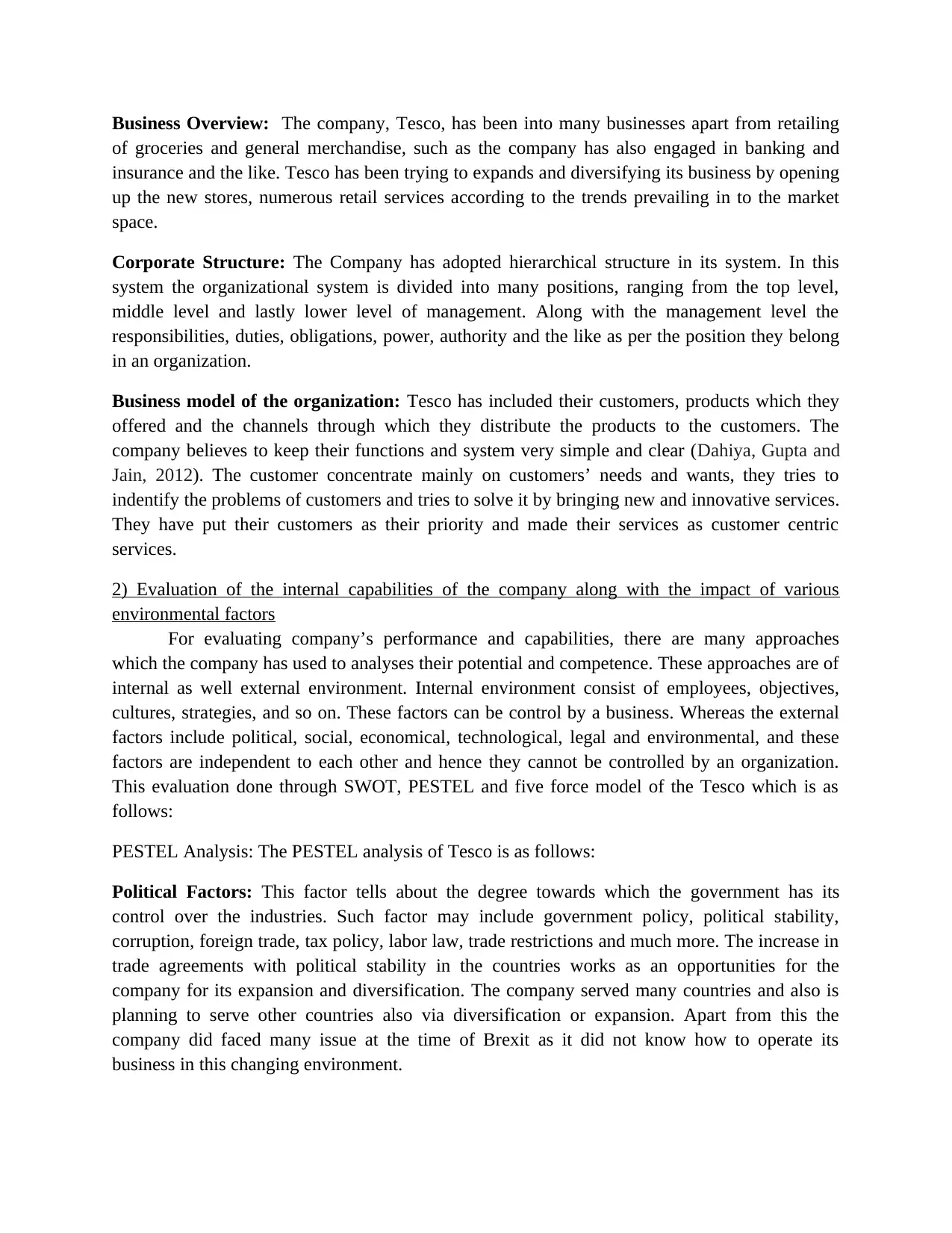
Business Overview: The company, Tesco, has been into many businesses apart from retailing
of groceries and general merchandise, such as the company has also engaged in banking and
insurance and the like. Tesco has been trying to expands and diversifying its business by opening
up the new stores, numerous retail services according to the trends prevailing in to the market
space.
Corporate Structure: The Company has adopted hierarchical structure in its system. In this
system the organizational system is divided into many positions, ranging from the top level,
middle level and lastly lower level of management. Along with the management level the
responsibilities, duties, obligations, power, authority and the like as per the position they belong
in an organization.
Business model of the organization: Tesco has included their customers, products which they
offered and the channels through which they distribute the products to the customers. The
company believes to keep their functions and system very simple and clear (Dahiya, Gupta and
Jain, 2012). The customer concentrate mainly on customers’ needs and wants, they tries to
indentify the problems of customers and tries to solve it by bringing new and innovative services.
They have put their customers as their priority and made their services as customer centric
services.
2) Evaluation of the internal capabilities of the company along with the impact of various
environmental factors
For evaluating company’s performance and capabilities, there are many approaches
which the company has used to analyses their potential and competence. These approaches are of
internal as well external environment. Internal environment consist of employees, objectives,
cultures, strategies, and so on. These factors can be control by a business. Whereas the external
factors include political, social, economical, technological, legal and environmental, and these
factors are independent to each other and hence they cannot be controlled by an organization.
This evaluation done through SWOT, PESTEL and five force model of the Tesco which is as
follows:
PESTEL Analysis: The PESTEL analysis of Tesco is as follows:
Political Factors: This factor tells about the degree towards which the government has its
control over the industries. Such factor may include government policy, political stability,
corruption, foreign trade, tax policy, labor law, trade restrictions and much more. The increase in
trade agreements with political stability in the countries works as an opportunities for the
company for its expansion and diversification. The company served many countries and also is
planning to serve other countries also via diversification or expansion. Apart from this the
company did faced many issue at the time of Brexit as it did not know how to operate its
business in this changing environment.
of groceries and general merchandise, such as the company has also engaged in banking and
insurance and the like. Tesco has been trying to expands and diversifying its business by opening
up the new stores, numerous retail services according to the trends prevailing in to the market
space.
Corporate Structure: The Company has adopted hierarchical structure in its system. In this
system the organizational system is divided into many positions, ranging from the top level,
middle level and lastly lower level of management. Along with the management level the
responsibilities, duties, obligations, power, authority and the like as per the position they belong
in an organization.
Business model of the organization: Tesco has included their customers, products which they
offered and the channels through which they distribute the products to the customers. The
company believes to keep their functions and system very simple and clear (Dahiya, Gupta and
Jain, 2012). The customer concentrate mainly on customers’ needs and wants, they tries to
indentify the problems of customers and tries to solve it by bringing new and innovative services.
They have put their customers as their priority and made their services as customer centric
services.
2) Evaluation of the internal capabilities of the company along with the impact of various
environmental factors
For evaluating company’s performance and capabilities, there are many approaches
which the company has used to analyses their potential and competence. These approaches are of
internal as well external environment. Internal environment consist of employees, objectives,
cultures, strategies, and so on. These factors can be control by a business. Whereas the external
factors include political, social, economical, technological, legal and environmental, and these
factors are independent to each other and hence they cannot be controlled by an organization.
This evaluation done through SWOT, PESTEL and five force model of the Tesco which is as
follows:
PESTEL Analysis: The PESTEL analysis of Tesco is as follows:
Political Factors: This factor tells about the degree towards which the government has its
control over the industries. Such factor may include government policy, political stability,
corruption, foreign trade, tax policy, labor law, trade restrictions and much more. The increase in
trade agreements with political stability in the countries works as an opportunities for the
company for its expansion and diversification. The company served many countries and also is
planning to serve other countries also via diversification or expansion. Apart from this the
company did faced many issue at the time of Brexit as it did not know how to operate its
business in this changing environment.
Paraphrase This Document
Need a fresh take? Get an instant paraphrase of this document with our AI Paraphraser
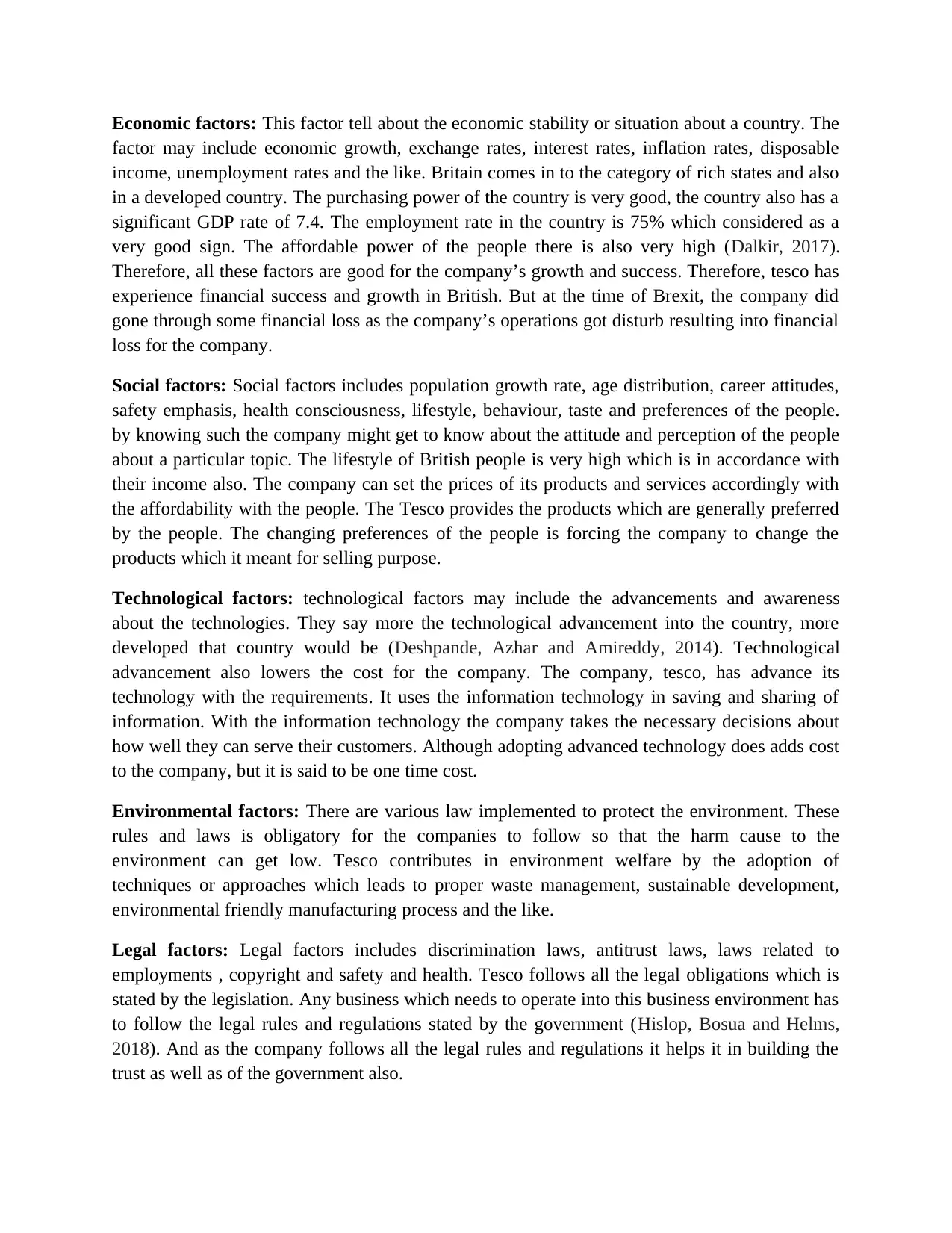
Economic factors: This factor tell about the economic stability or situation about a country. The
factor may include economic growth, exchange rates, interest rates, inflation rates, disposable
income, unemployment rates and the like. Britain comes in to the category of rich states and also
in a developed country. The purchasing power of the country is very good, the country also has a
significant GDP rate of 7.4. The employment rate in the country is 75% which considered as a
very good sign. The affordable power of the people there is also very high (Dalkir, 2017).
Therefore, all these factors are good for the company’s growth and success. Therefore, tesco has
experience financial success and growth in British. But at the time of Brexit, the company did
gone through some financial loss as the company’s operations got disturb resulting into financial
loss for the company.
Social factors: Social factors includes population growth rate, age distribution, career attitudes,
safety emphasis, health consciousness, lifestyle, behaviour, taste and preferences of the people.
by knowing such the company might get to know about the attitude and perception of the people
about a particular topic. The lifestyle of British people is very high which is in accordance with
their income also. The company can set the prices of its products and services accordingly with
the affordability with the people. The Tesco provides the products which are generally preferred
by the people. The changing preferences of the people is forcing the company to change the
products which it meant for selling purpose.
Technological factors: technological factors may include the advancements and awareness
about the technologies. They say more the technological advancement into the country, more
developed that country would be (Deshpande, Azhar and Amireddy, 2014). Technological
advancement also lowers the cost for the company. The company, tesco, has advance its
technology with the requirements. It uses the information technology in saving and sharing of
information. With the information technology the company takes the necessary decisions about
how well they can serve their customers. Although adopting advanced technology does adds cost
to the company, but it is said to be one time cost.
Environmental factors: There are various law implemented to protect the environment. These
rules and laws is obligatory for the companies to follow so that the harm cause to the
environment can get low. Tesco contributes in environment welfare by the adoption of
techniques or approaches which leads to proper waste management, sustainable development,
environmental friendly manufacturing process and the like.
Legal factors: Legal factors includes discrimination laws, antitrust laws, laws related to
employments , copyright and safety and health. Tesco follows all the legal obligations which is
stated by the legislation. Any business which needs to operate into this business environment has
to follow the legal rules and regulations stated by the government (Hislop, Bosua and Helms,
2018). And as the company follows all the legal rules and regulations it helps it in building the
trust as well as of the government also.
factor may include economic growth, exchange rates, interest rates, inflation rates, disposable
income, unemployment rates and the like. Britain comes in to the category of rich states and also
in a developed country. The purchasing power of the country is very good, the country also has a
significant GDP rate of 7.4. The employment rate in the country is 75% which considered as a
very good sign. The affordable power of the people there is also very high (Dalkir, 2017).
Therefore, all these factors are good for the company’s growth and success. Therefore, tesco has
experience financial success and growth in British. But at the time of Brexit, the company did
gone through some financial loss as the company’s operations got disturb resulting into financial
loss for the company.
Social factors: Social factors includes population growth rate, age distribution, career attitudes,
safety emphasis, health consciousness, lifestyle, behaviour, taste and preferences of the people.
by knowing such the company might get to know about the attitude and perception of the people
about a particular topic. The lifestyle of British people is very high which is in accordance with
their income also. The company can set the prices of its products and services accordingly with
the affordability with the people. The Tesco provides the products which are generally preferred
by the people. The changing preferences of the people is forcing the company to change the
products which it meant for selling purpose.
Technological factors: technological factors may include the advancements and awareness
about the technologies. They say more the technological advancement into the country, more
developed that country would be (Deshpande, Azhar and Amireddy, 2014). Technological
advancement also lowers the cost for the company. The company, tesco, has advance its
technology with the requirements. It uses the information technology in saving and sharing of
information. With the information technology the company takes the necessary decisions about
how well they can serve their customers. Although adopting advanced technology does adds cost
to the company, but it is said to be one time cost.
Environmental factors: There are various law implemented to protect the environment. These
rules and laws is obligatory for the companies to follow so that the harm cause to the
environment can get low. Tesco contributes in environment welfare by the adoption of
techniques or approaches which leads to proper waste management, sustainable development,
environmental friendly manufacturing process and the like.
Legal factors: Legal factors includes discrimination laws, antitrust laws, laws related to
employments , copyright and safety and health. Tesco follows all the legal obligations which is
stated by the legislation. Any business which needs to operate into this business environment has
to follow the legal rules and regulations stated by the government (Hislop, Bosua and Helms,
2018). And as the company follows all the legal rules and regulations it helps it in building the
trust as well as of the government also.
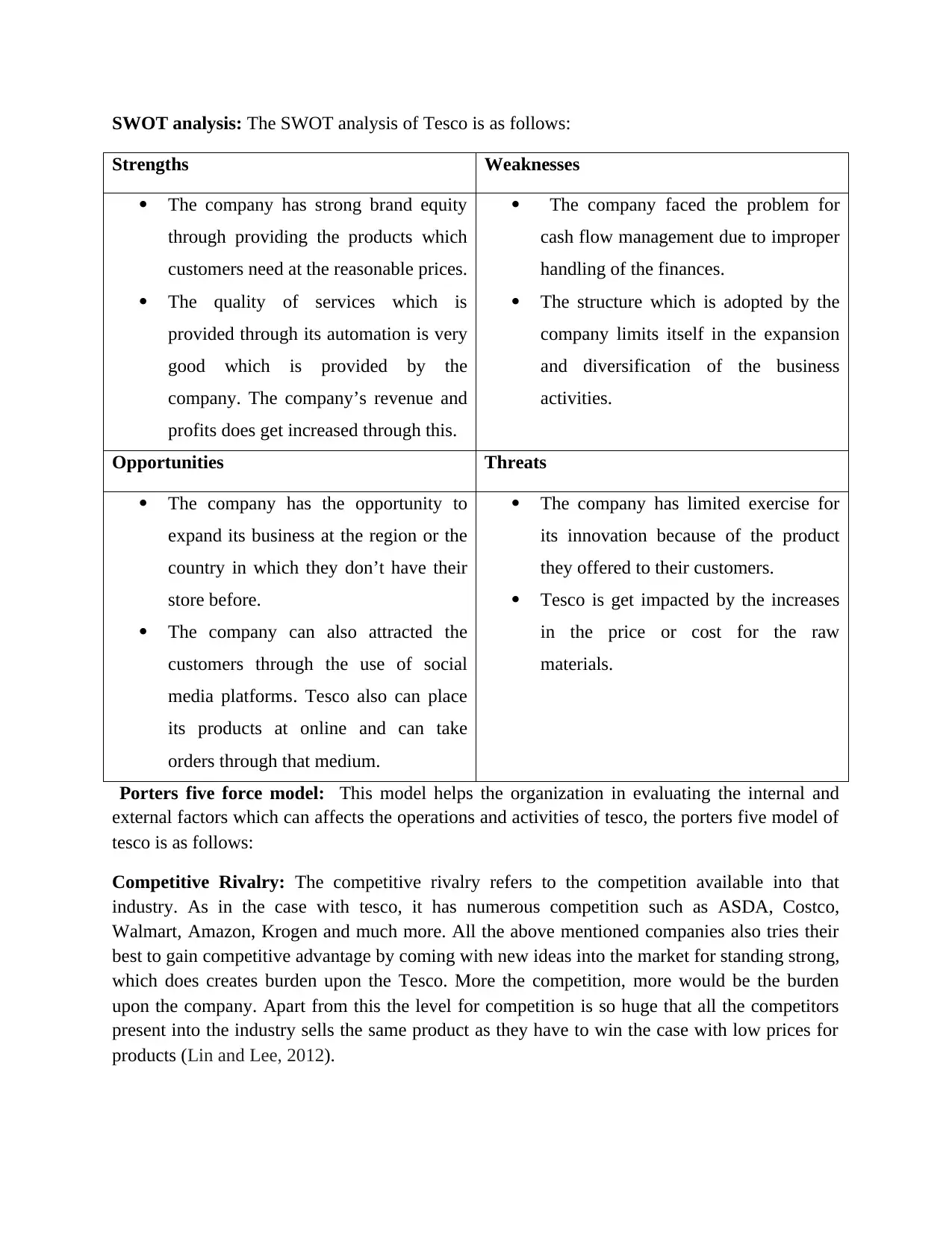
SWOT analysis: The SWOT analysis of Tesco is as follows:
Strengths Weaknesses
The company has strong brand equity
through providing the products which
customers need at the reasonable prices.
The quality of services which is
provided through its automation is very
good which is provided by the
company. The company’s revenue and
profits does get increased through this.
The company faced the problem for
cash flow management due to improper
handling of the finances.
The structure which is adopted by the
company limits itself in the expansion
and diversification of the business
activities.
Opportunities Threats
The company has the opportunity to
expand its business at the region or the
country in which they don’t have their
store before.
The company can also attracted the
customers through the use of social
media platforms. Tesco also can place
its products at online and can take
orders through that medium.
The company has limited exercise for
its innovation because of the product
they offered to their customers.
Tesco is get impacted by the increases
in the price or cost for the raw
materials.
Porters five force model: This model helps the organization in evaluating the internal and
external factors which can affects the operations and activities of tesco, the porters five model of
tesco is as follows:
Competitive Rivalry: The competitive rivalry refers to the competition available into that
industry. As in the case with tesco, it has numerous competition such as ASDA, Costco,
Walmart, Amazon, Krogen and much more. All the above mentioned companies also tries their
best to gain competitive advantage by coming with new ideas into the market for standing strong,
which does creates burden upon the Tesco. More the competition, more would be the burden
upon the company. Apart from this the level for competition is so huge that all the competitors
present into the industry sells the same product as they have to win the case with low prices for
products (Lin and Lee, 2012).
Strengths Weaknesses
The company has strong brand equity
through providing the products which
customers need at the reasonable prices.
The quality of services which is
provided through its automation is very
good which is provided by the
company. The company’s revenue and
profits does get increased through this.
The company faced the problem for
cash flow management due to improper
handling of the finances.
The structure which is adopted by the
company limits itself in the expansion
and diversification of the business
activities.
Opportunities Threats
The company has the opportunity to
expand its business at the region or the
country in which they don’t have their
store before.
The company can also attracted the
customers through the use of social
media platforms. Tesco also can place
its products at online and can take
orders through that medium.
The company has limited exercise for
its innovation because of the product
they offered to their customers.
Tesco is get impacted by the increases
in the price or cost for the raw
materials.
Porters five force model: This model helps the organization in evaluating the internal and
external factors which can affects the operations and activities of tesco, the porters five model of
tesco is as follows:
Competitive Rivalry: The competitive rivalry refers to the competition available into that
industry. As in the case with tesco, it has numerous competition such as ASDA, Costco,
Walmart, Amazon, Krogen and much more. All the above mentioned companies also tries their
best to gain competitive advantage by coming with new ideas into the market for standing strong,
which does creates burden upon the Tesco. More the competition, more would be the burden
upon the company. Apart from this the level for competition is so huge that all the competitors
present into the industry sells the same product as they have to win the case with low prices for
products (Lin and Lee, 2012).
⊘ This is a preview!⊘
Do you want full access?
Subscribe today to unlock all pages.

Trusted by 1+ million students worldwide
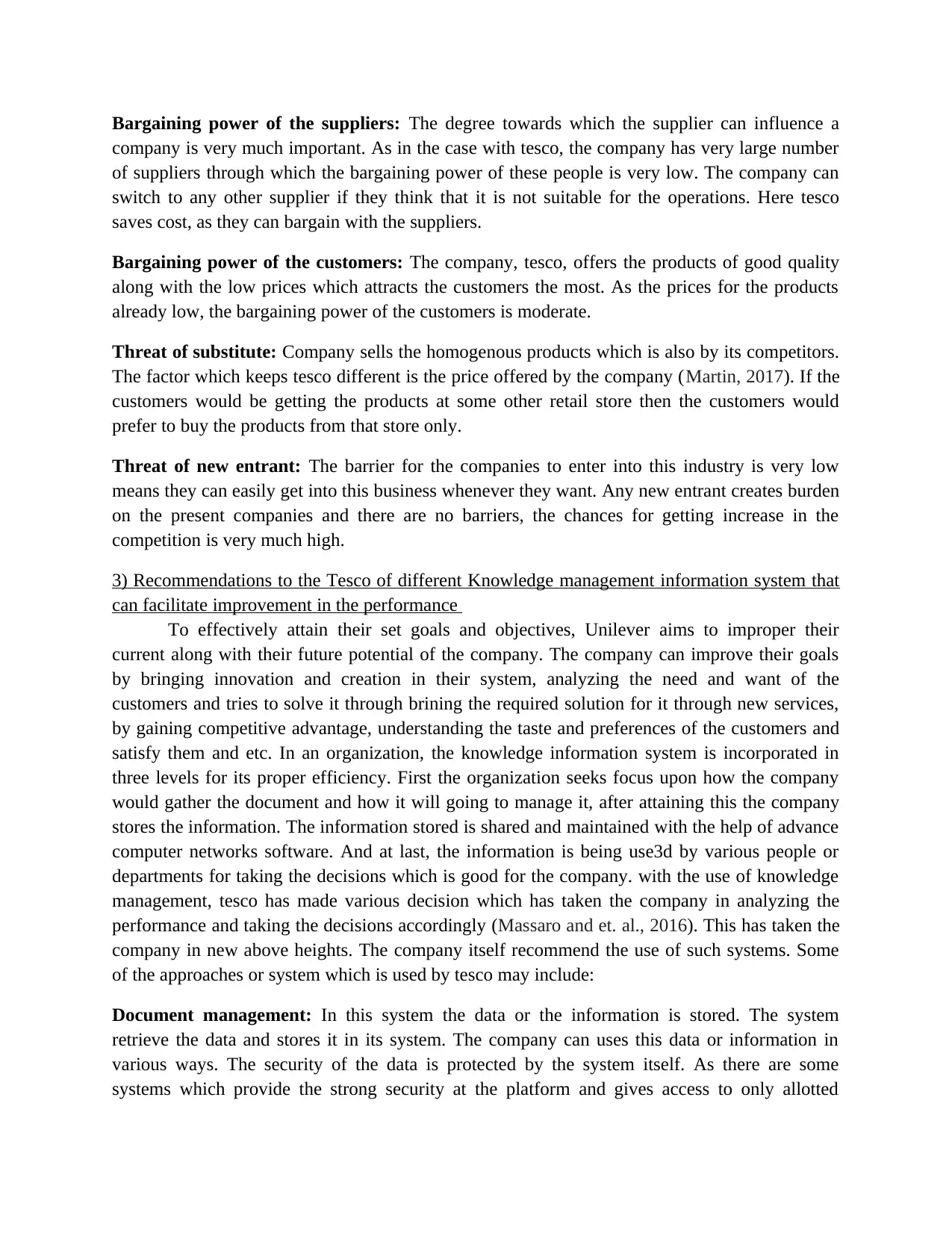
Bargaining power of the suppliers: The degree towards which the supplier can influence a
company is very much important. As in the case with tesco, the company has very large number
of suppliers through which the bargaining power of these people is very low. The company can
switch to any other supplier if they think that it is not suitable for the operations. Here tesco
saves cost, as they can bargain with the suppliers.
Bargaining power of the customers: The company, tesco, offers the products of good quality
along with the low prices which attracts the customers the most. As the prices for the products
already low, the bargaining power of the customers is moderate.
Threat of substitute: Company sells the homogenous products which is also by its competitors.
The factor which keeps tesco different is the price offered by the company (Martin, 2017). If the
customers would be getting the products at some other retail store then the customers would
prefer to buy the products from that store only.
Threat of new entrant: The barrier for the companies to enter into this industry is very low
means they can easily get into this business whenever they want. Any new entrant creates burden
on the present companies and there are no barriers, the chances for getting increase in the
competition is very much high.
3) Recommendations to the Tesco of different Knowledge management information system that
can facilitate improvement in the performance
To effectively attain their set goals and objectives, Unilever aims to improper their
current along with their future potential of the company. The company can improve their goals
by bringing innovation and creation in their system, analyzing the need and want of the
customers and tries to solve it through brining the required solution for it through new services,
by gaining competitive advantage, understanding the taste and preferences of the customers and
satisfy them and etc. In an organization, the knowledge information system is incorporated in
three levels for its proper efficiency. First the organization seeks focus upon how the company
would gather the document and how it will going to manage it, after attaining this the company
stores the information. The information stored is shared and maintained with the help of advance
computer networks software. And at last, the information is being use3d by various people or
departments for taking the decisions which is good for the company. with the use of knowledge
management, tesco has made various decision which has taken the company in analyzing the
performance and taking the decisions accordingly (Massaro and et. al., 2016). This has taken the
company in new above heights. The company itself recommend the use of such systems. Some
of the approaches or system which is used by tesco may include:
Document management: In this system the data or the information is stored. The system
retrieve the data and stores it in its system. The company can uses this data or information in
various ways. The security of the data is protected by the system itself. As there are some
systems which provide the strong security at the platform and gives access to only allotted
company is very much important. As in the case with tesco, the company has very large number
of suppliers through which the bargaining power of these people is very low. The company can
switch to any other supplier if they think that it is not suitable for the operations. Here tesco
saves cost, as they can bargain with the suppliers.
Bargaining power of the customers: The company, tesco, offers the products of good quality
along with the low prices which attracts the customers the most. As the prices for the products
already low, the bargaining power of the customers is moderate.
Threat of substitute: Company sells the homogenous products which is also by its competitors.
The factor which keeps tesco different is the price offered by the company (Martin, 2017). If the
customers would be getting the products at some other retail store then the customers would
prefer to buy the products from that store only.
Threat of new entrant: The barrier for the companies to enter into this industry is very low
means they can easily get into this business whenever they want. Any new entrant creates burden
on the present companies and there are no barriers, the chances for getting increase in the
competition is very much high.
3) Recommendations to the Tesco of different Knowledge management information system that
can facilitate improvement in the performance
To effectively attain their set goals and objectives, Unilever aims to improper their
current along with their future potential of the company. The company can improve their goals
by bringing innovation and creation in their system, analyzing the need and want of the
customers and tries to solve it through brining the required solution for it through new services,
by gaining competitive advantage, understanding the taste and preferences of the customers and
satisfy them and etc. In an organization, the knowledge information system is incorporated in
three levels for its proper efficiency. First the organization seeks focus upon how the company
would gather the document and how it will going to manage it, after attaining this the company
stores the information. The information stored is shared and maintained with the help of advance
computer networks software. And at last, the information is being use3d by various people or
departments for taking the decisions which is good for the company. with the use of knowledge
management, tesco has made various decision which has taken the company in analyzing the
performance and taking the decisions accordingly (Massaro and et. al., 2016). This has taken the
company in new above heights. The company itself recommend the use of such systems. Some
of the approaches or system which is used by tesco may include:
Document management: In this system the data or the information is stored. The system
retrieve the data and stores it in its system. The company can uses this data or information in
various ways. The security of the data is protected by the system itself. As there are some
systems which provide the strong security at the platform and gives access to only allotted
Paraphrase This Document
Need a fresh take? Get an instant paraphrase of this document with our AI Paraphraser
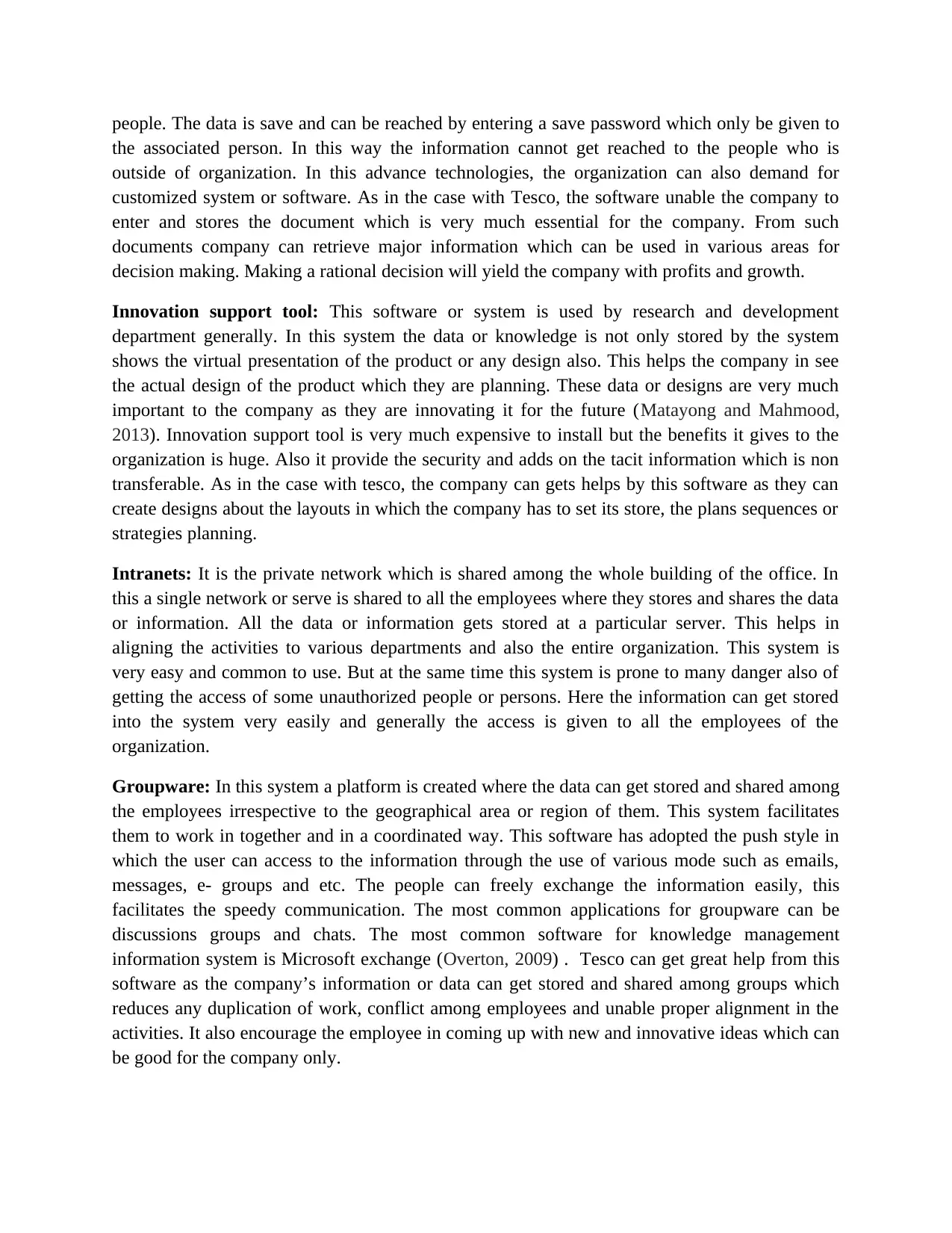
people. The data is save and can be reached by entering a save password which only be given to
the associated person. In this way the information cannot get reached to the people who is
outside of organization. In this advance technologies, the organization can also demand for
customized system or software. As in the case with Tesco, the software unable the company to
enter and stores the document which is very much essential for the company. From such
documents company can retrieve major information which can be used in various areas for
decision making. Making a rational decision will yield the company with profits and growth.
Innovation support tool: This software or system is used by research and development
department generally. In this system the data or knowledge is not only stored by the system
shows the virtual presentation of the product or any design also. This helps the company in see
the actual design of the product which they are planning. These data or designs are very much
important to the company as they are innovating it for the future (Matayong and Mahmood,
2013). Innovation support tool is very much expensive to install but the benefits it gives to the
organization is huge. Also it provide the security and adds on the tacit information which is non
transferable. As in the case with tesco, the company can gets helps by this software as they can
create designs about the layouts in which the company has to set its store, the plans sequences or
strategies planning.
Intranets: It is the private network which is shared among the whole building of the office. In
this a single network or serve is shared to all the employees where they stores and shares the data
or information. All the data or information gets stored at a particular server. This helps in
aligning the activities to various departments and also the entire organization. This system is
very easy and common to use. But at the same time this system is prone to many danger also of
getting the access of some unauthorized people or persons. Here the information can get stored
into the system very easily and generally the access is given to all the employees of the
organization.
Groupware: In this system a platform is created where the data can get stored and shared among
the employees irrespective to the geographical area or region of them. This system facilitates
them to work in together and in a coordinated way. This software has adopted the push style in
which the user can access to the information through the use of various mode such as emails,
messages, e- groups and etc. The people can freely exchange the information easily, this
facilitates the speedy communication. The most common applications for groupware can be
discussions groups and chats. The most common software for knowledge management
information system is Microsoft exchange (Overton, 2009) . Tesco can get great help from this
software as the company’s information or data can get stored and shared among groups which
reduces any duplication of work, conflict among employees and unable proper alignment in the
activities. It also encourage the employee in coming up with new and innovative ideas which can
be good for the company only.
the associated person. In this way the information cannot get reached to the people who is
outside of organization. In this advance technologies, the organization can also demand for
customized system or software. As in the case with Tesco, the software unable the company to
enter and stores the document which is very much essential for the company. From such
documents company can retrieve major information which can be used in various areas for
decision making. Making a rational decision will yield the company with profits and growth.
Innovation support tool: This software or system is used by research and development
department generally. In this system the data or knowledge is not only stored by the system
shows the virtual presentation of the product or any design also. This helps the company in see
the actual design of the product which they are planning. These data or designs are very much
important to the company as they are innovating it for the future (Matayong and Mahmood,
2013). Innovation support tool is very much expensive to install but the benefits it gives to the
organization is huge. Also it provide the security and adds on the tacit information which is non
transferable. As in the case with tesco, the company can gets helps by this software as they can
create designs about the layouts in which the company has to set its store, the plans sequences or
strategies planning.
Intranets: It is the private network which is shared among the whole building of the office. In
this a single network or serve is shared to all the employees where they stores and shares the data
or information. All the data or information gets stored at a particular server. This helps in
aligning the activities to various departments and also the entire organization. This system is
very easy and common to use. But at the same time this system is prone to many danger also of
getting the access of some unauthorized people or persons. Here the information can get stored
into the system very easily and generally the access is given to all the employees of the
organization.
Groupware: In this system a platform is created where the data can get stored and shared among
the employees irrespective to the geographical area or region of them. This system facilitates
them to work in together and in a coordinated way. This software has adopted the push style in
which the user can access to the information through the use of various mode such as emails,
messages, e- groups and etc. The people can freely exchange the information easily, this
facilitates the speedy communication. The most common applications for groupware can be
discussions groups and chats. The most common software for knowledge management
information system is Microsoft exchange (Overton, 2009) . Tesco can get great help from this
software as the company’s information or data can get stored and shared among groups which
reduces any duplication of work, conflict among employees and unable proper alignment in the
activities. It also encourage the employee in coming up with new and innovative ideas which can
be good for the company only.
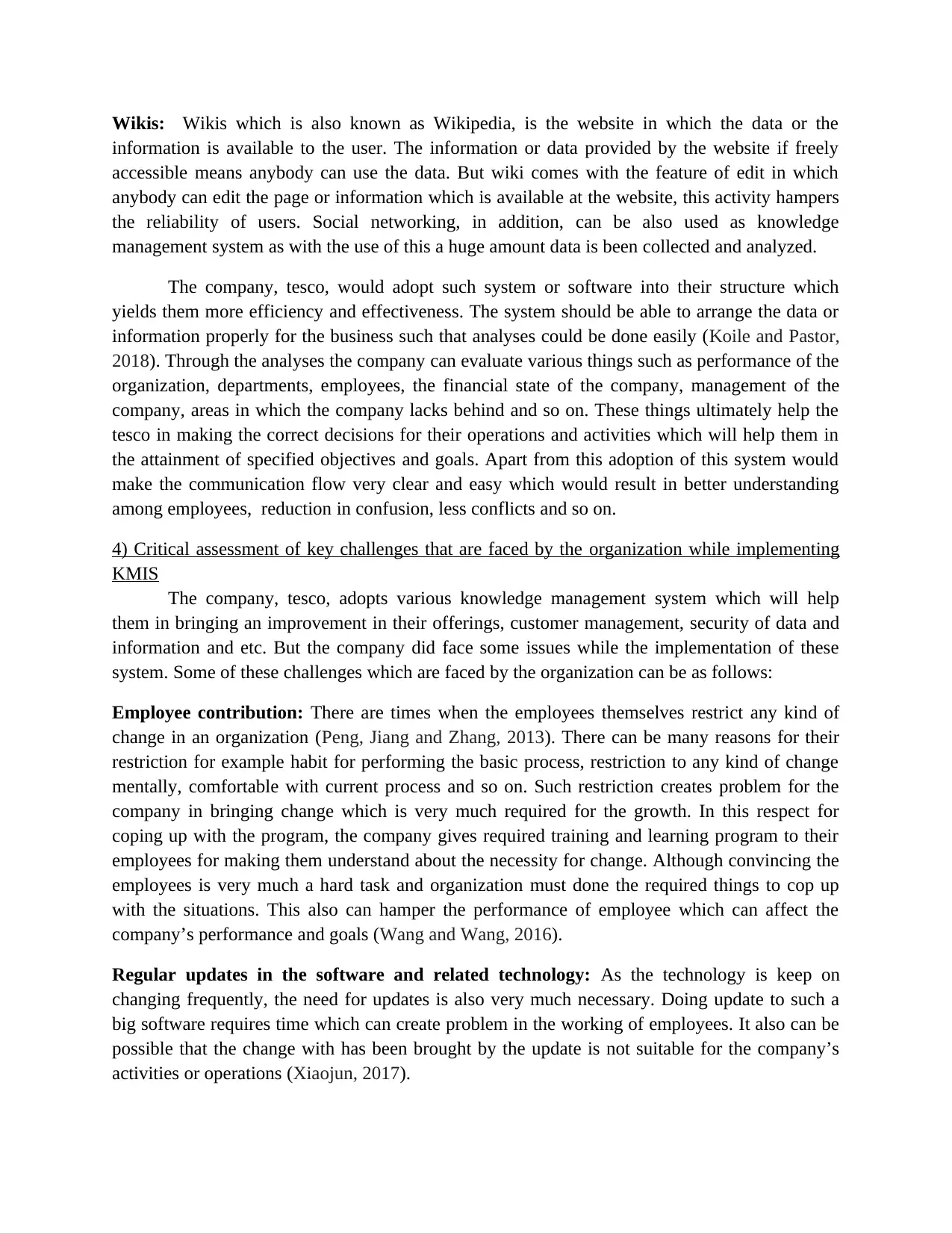
Wikis: Wikis which is also known as Wikipedia, is the website in which the data or the
information is available to the user. The information or data provided by the website if freely
accessible means anybody can use the data. But wiki comes with the feature of edit in which
anybody can edit the page or information which is available at the website, this activity hampers
the reliability of users. Social networking, in addition, can be also used as knowledge
management system as with the use of this a huge amount data is been collected and analyzed.
The company, tesco, would adopt such system or software into their structure which
yields them more efficiency and effectiveness. The system should be able to arrange the data or
information properly for the business such that analyses could be done easily (Koile and Pastor,
2018). Through the analyses the company can evaluate various things such as performance of the
organization, departments, employees, the financial state of the company, management of the
company, areas in which the company lacks behind and so on. These things ultimately help the
tesco in making the correct decisions for their operations and activities which will help them in
the attainment of specified objectives and goals. Apart from this adoption of this system would
make the communication flow very clear and easy which would result in better understanding
among employees, reduction in confusion, less conflicts and so on.
4) Critical assessment of key challenges that are faced by the organization while implementing
KMIS
The company, tesco, adopts various knowledge management system which will help
them in bringing an improvement in their offerings, customer management, security of data and
information and etc. But the company did face some issues while the implementation of these
system. Some of these challenges which are faced by the organization can be as follows:
Employee contribution: There are times when the employees themselves restrict any kind of
change in an organization (Peng, Jiang and Zhang, 2013). There can be many reasons for their
restriction for example habit for performing the basic process, restriction to any kind of change
mentally, comfortable with current process and so on. Such restriction creates problem for the
company in bringing change which is very much required for the growth. In this respect for
coping up with the program, the company gives required training and learning program to their
employees for making them understand about the necessity for change. Although convincing the
employees is very much a hard task and organization must done the required things to cop up
with the situations. This also can hamper the performance of employee which can affect the
company’s performance and goals (Wang and Wang, 2016).
Regular updates in the software and related technology: As the technology is keep on
changing frequently, the need for updates is also very much necessary. Doing update to such a
big software requires time which can create problem in the working of employees. It also can be
possible that the change with has been brought by the update is not suitable for the company’s
activities or operations (Xiaojun, 2017).
information is available to the user. The information or data provided by the website if freely
accessible means anybody can use the data. But wiki comes with the feature of edit in which
anybody can edit the page or information which is available at the website, this activity hampers
the reliability of users. Social networking, in addition, can be also used as knowledge
management system as with the use of this a huge amount data is been collected and analyzed.
The company, tesco, would adopt such system or software into their structure which
yields them more efficiency and effectiveness. The system should be able to arrange the data or
information properly for the business such that analyses could be done easily (Koile and Pastor,
2018). Through the analyses the company can evaluate various things such as performance of the
organization, departments, employees, the financial state of the company, management of the
company, areas in which the company lacks behind and so on. These things ultimately help the
tesco in making the correct decisions for their operations and activities which will help them in
the attainment of specified objectives and goals. Apart from this adoption of this system would
make the communication flow very clear and easy which would result in better understanding
among employees, reduction in confusion, less conflicts and so on.
4) Critical assessment of key challenges that are faced by the organization while implementing
KMIS
The company, tesco, adopts various knowledge management system which will help
them in bringing an improvement in their offerings, customer management, security of data and
information and etc. But the company did face some issues while the implementation of these
system. Some of these challenges which are faced by the organization can be as follows:
Employee contribution: There are times when the employees themselves restrict any kind of
change in an organization (Peng, Jiang and Zhang, 2013). There can be many reasons for their
restriction for example habit for performing the basic process, restriction to any kind of change
mentally, comfortable with current process and so on. Such restriction creates problem for the
company in bringing change which is very much required for the growth. In this respect for
coping up with the program, the company gives required training and learning program to their
employees for making them understand about the necessity for change. Although convincing the
employees is very much a hard task and organization must done the required things to cop up
with the situations. This also can hamper the performance of employee which can affect the
company’s performance and goals (Wang and Wang, 2016).
Regular updates in the software and related technology: As the technology is keep on
changing frequently, the need for updates is also very much necessary. Doing update to such a
big software requires time which can create problem in the working of employees. It also can be
possible that the change with has been brought by the update is not suitable for the company’s
activities or operations (Xiaojun, 2017).
⊘ This is a preview!⊘
Do you want full access?
Subscribe today to unlock all pages.

Trusted by 1+ million students worldwide
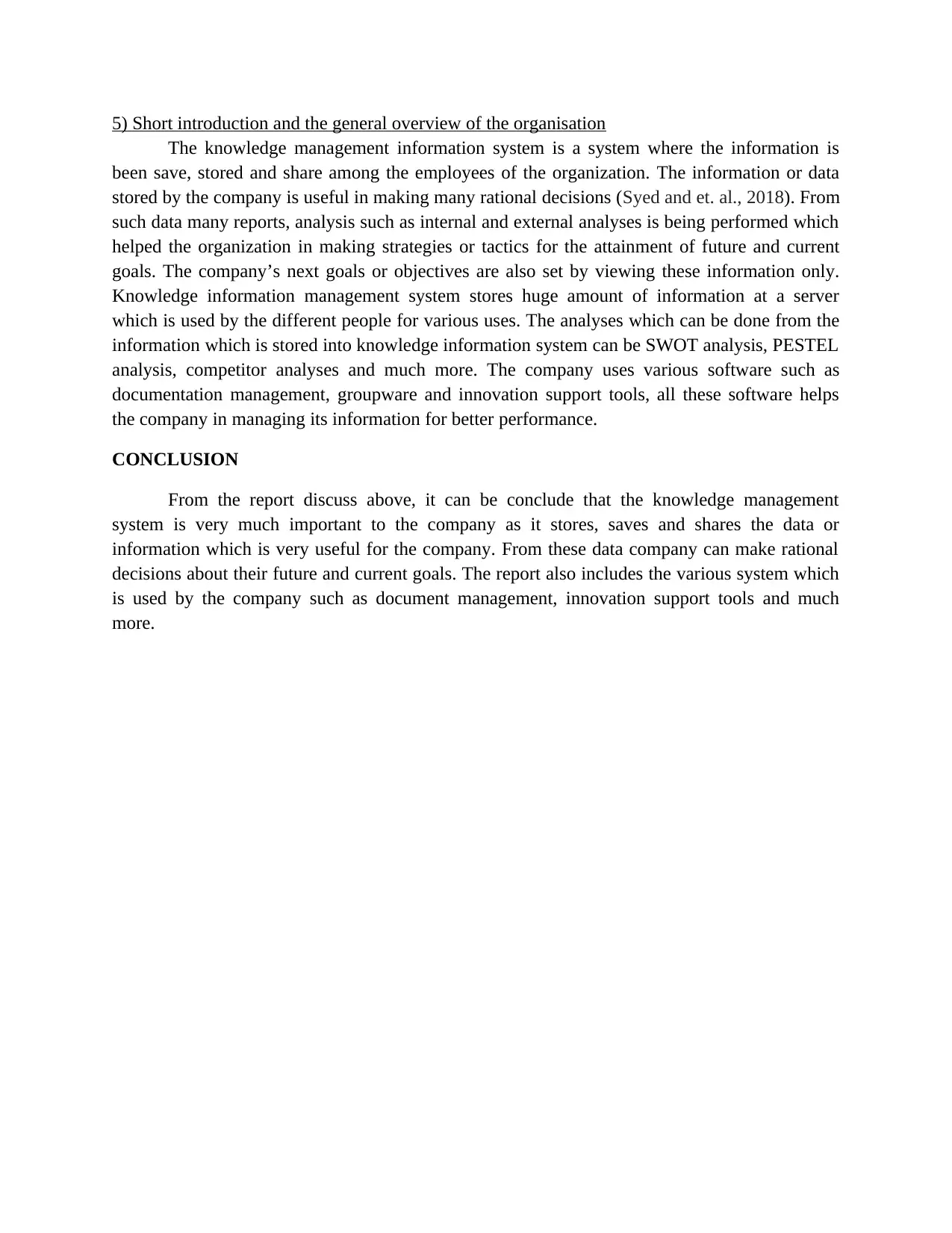
5) Short introduction and the general overview of the organisation
The knowledge management information system is a system where the information is
been save, stored and share among the employees of the organization. The information or data
stored by the company is useful in making many rational decisions (Syed and et. al., 2018). From
such data many reports, analysis such as internal and external analyses is being performed which
helped the organization in making strategies or tactics for the attainment of future and current
goals. The company’s next goals or objectives are also set by viewing these information only.
Knowledge information management system stores huge amount of information at a server
which is used by the different people for various uses. The analyses which can be done from the
information which is stored into knowledge information system can be SWOT analysis, PESTEL
analysis, competitor analyses and much more. The company uses various software such as
documentation management, groupware and innovation support tools, all these software helps
the company in managing its information for better performance.
CONCLUSION
From the report discuss above, it can be conclude that the knowledge management
system is very much important to the company as it stores, saves and shares the data or
information which is very useful for the company. From these data company can make rational
decisions about their future and current goals. The report also includes the various system which
is used by the company such as document management, innovation support tools and much
more.
The knowledge management information system is a system where the information is
been save, stored and share among the employees of the organization. The information or data
stored by the company is useful in making many rational decisions (Syed and et. al., 2018). From
such data many reports, analysis such as internal and external analyses is being performed which
helped the organization in making strategies or tactics for the attainment of future and current
goals. The company’s next goals or objectives are also set by viewing these information only.
Knowledge information management system stores huge amount of information at a server
which is used by the different people for various uses. The analyses which can be done from the
information which is stored into knowledge information system can be SWOT analysis, PESTEL
analysis, competitor analyses and much more. The company uses various software such as
documentation management, groupware and innovation support tools, all these software helps
the company in managing its information for better performance.
CONCLUSION
From the report discuss above, it can be conclude that the knowledge management
system is very much important to the company as it stores, saves and shares the data or
information which is very useful for the company. From these data company can make rational
decisions about their future and current goals. The report also includes the various system which
is used by the company such as document management, innovation support tools and much
more.
Paraphrase This Document
Need a fresh take? Get an instant paraphrase of this document with our AI Paraphraser
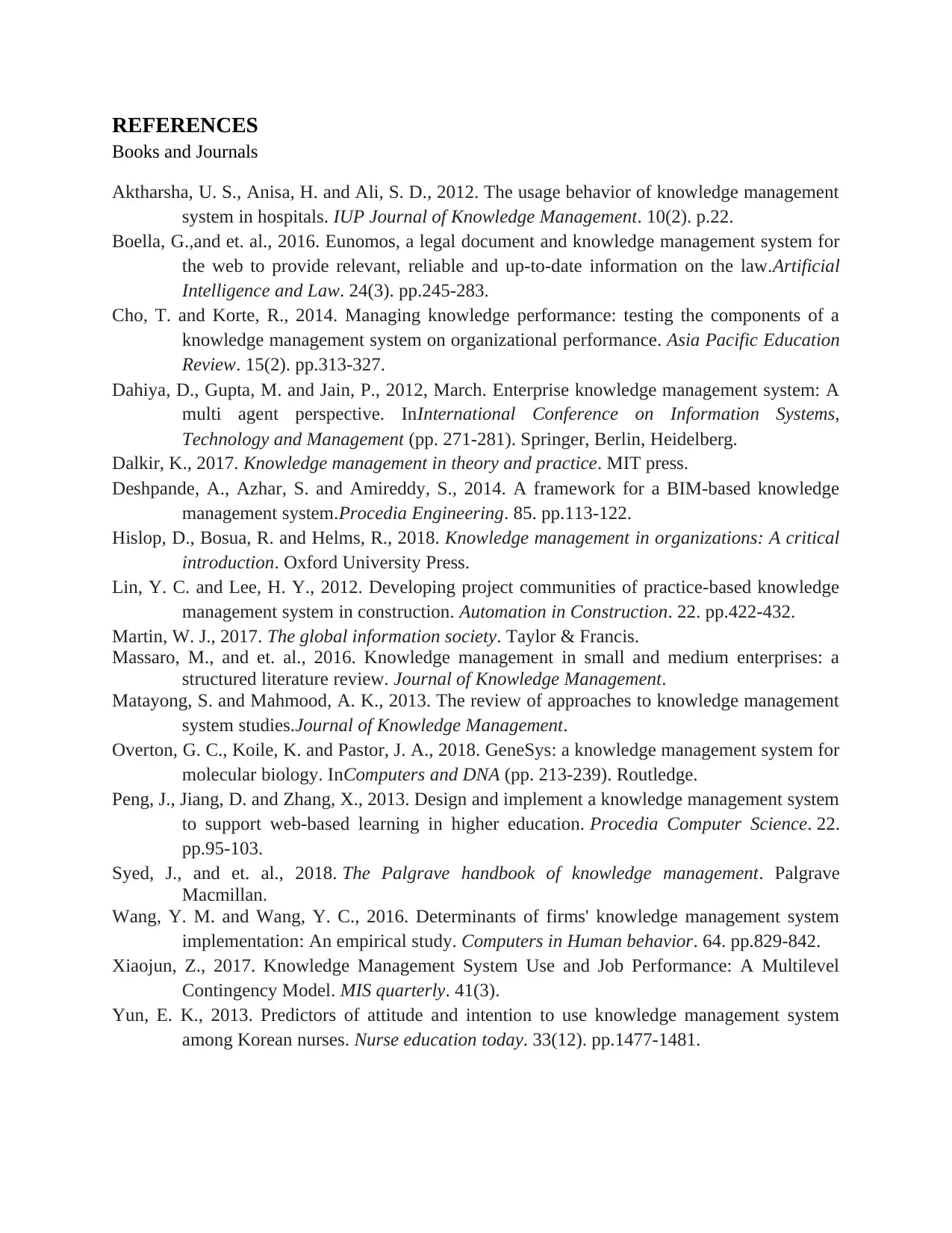
REFERENCES
Books and Journals
Aktharsha, U. S., Anisa, H. and Ali, S. D., 2012. The usage behavior of knowledge management
system in hospitals. IUP Journal of Knowledge Management. 10(2). p.22.
Boella, G.,and et. al., 2016. Eunomos, a legal document and knowledge management system for
the web to provide relevant, reliable and up-to-date information on the law.Artificial
Intelligence and Law. 24(3). pp.245-283.
Cho, T. and Korte, R., 2014. Managing knowledge performance: testing the components of a
knowledge management system on organizational performance. Asia Pacific Education
Review. 15(2). pp.313-327.
Dahiya, D., Gupta, M. and Jain, P., 2012, March. Enterprise knowledge management system: A
multi agent perspective. InInternational Conference on Information Systems,
Technology and Management (pp. 271-281). Springer, Berlin, Heidelberg.
Dalkir, K., 2017. Knowledge management in theory and practice. MIT press.
Deshpande, A., Azhar, S. and Amireddy, S., 2014. A framework for a BIM-based knowledge
management system.Procedia Engineering. 85. pp.113-122.
Hislop, D., Bosua, R. and Helms, R., 2018. Knowledge management in organizations: A critical
introduction. Oxford University Press.
Lin, Y. C. and Lee, H. Y., 2012. Developing project communities of practice-based knowledge
management system in construction. Automation in Construction. 22. pp.422-432.
Martin, W. J., 2017. The global information society. Taylor & Francis.
Massaro, M., and et. al., 2016. Knowledge management in small and medium enterprises: a
structured literature review. Journal of Knowledge Management.
Matayong, S. and Mahmood, A. K., 2013. The review of approaches to knowledge management
system studies.Journal of Knowledge Management.
Overton, G. C., Koile, K. and Pastor, J. A., 2018. GeneSys: a knowledge management system for
molecular biology. InComputers and DNA (pp. 213-239). Routledge.
Peng, J., Jiang, D. and Zhang, X., 2013. Design and implement a knowledge management system
to support web-based learning in higher education. Procedia Computer Science. 22.
pp.95-103.
Syed, J., and et. al., 2018. The Palgrave handbook of knowledge management. Palgrave
Macmillan.
Wang, Y. M. and Wang, Y. C., 2016. Determinants of firms' knowledge management system
implementation: An empirical study. Computers in Human behavior. 64. pp.829-842.
Xiaojun, Z., 2017. Knowledge Management System Use and Job Performance: A Multilevel
Contingency Model. MIS quarterly. 41(3).
Yun, E. K., 2013. Predictors of attitude and intention to use knowledge management system
among Korean nurses. Nurse education today. 33(12). pp.1477-1481.
Books and Journals
Aktharsha, U. S., Anisa, H. and Ali, S. D., 2012. The usage behavior of knowledge management
system in hospitals. IUP Journal of Knowledge Management. 10(2). p.22.
Boella, G.,and et. al., 2016. Eunomos, a legal document and knowledge management system for
the web to provide relevant, reliable and up-to-date information on the law.Artificial
Intelligence and Law. 24(3). pp.245-283.
Cho, T. and Korte, R., 2014. Managing knowledge performance: testing the components of a
knowledge management system on organizational performance. Asia Pacific Education
Review. 15(2). pp.313-327.
Dahiya, D., Gupta, M. and Jain, P., 2012, March. Enterprise knowledge management system: A
multi agent perspective. InInternational Conference on Information Systems,
Technology and Management (pp. 271-281). Springer, Berlin, Heidelberg.
Dalkir, K., 2017. Knowledge management in theory and practice. MIT press.
Deshpande, A., Azhar, S. and Amireddy, S., 2014. A framework for a BIM-based knowledge
management system.Procedia Engineering. 85. pp.113-122.
Hislop, D., Bosua, R. and Helms, R., 2018. Knowledge management in organizations: A critical
introduction. Oxford University Press.
Lin, Y. C. and Lee, H. Y., 2012. Developing project communities of practice-based knowledge
management system in construction. Automation in Construction. 22. pp.422-432.
Martin, W. J., 2017. The global information society. Taylor & Francis.
Massaro, M., and et. al., 2016. Knowledge management in small and medium enterprises: a
structured literature review. Journal of Knowledge Management.
Matayong, S. and Mahmood, A. K., 2013. The review of approaches to knowledge management
system studies.Journal of Knowledge Management.
Overton, G. C., Koile, K. and Pastor, J. A., 2018. GeneSys: a knowledge management system for
molecular biology. InComputers and DNA (pp. 213-239). Routledge.
Peng, J., Jiang, D. and Zhang, X., 2013. Design and implement a knowledge management system
to support web-based learning in higher education. Procedia Computer Science. 22.
pp.95-103.
Syed, J., and et. al., 2018. The Palgrave handbook of knowledge management. Palgrave
Macmillan.
Wang, Y. M. and Wang, Y. C., 2016. Determinants of firms' knowledge management system
implementation: An empirical study. Computers in Human behavior. 64. pp.829-842.
Xiaojun, Z., 2017. Knowledge Management System Use and Job Performance: A Multilevel
Contingency Model. MIS quarterly. 41(3).
Yun, E. K., 2013. Predictors of attitude and intention to use knowledge management system
among Korean nurses. Nurse education today. 33(12). pp.1477-1481.

⊘ This is a preview!⊘
Do you want full access?
Subscribe today to unlock all pages.

Trusted by 1+ million students worldwide
1 out of 12
Related Documents
Your All-in-One AI-Powered Toolkit for Academic Success.
+13062052269
info@desklib.com
Available 24*7 on WhatsApp / Email
![[object Object]](/_next/static/media/star-bottom.7253800d.svg)
Unlock your academic potential
Copyright © 2020–2025 A2Z Services. All Rights Reserved. Developed and managed by ZUCOL.





